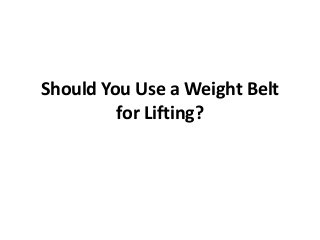Should You Use a Weight Belt for Lifting?
•Download as PPTX, PDF•
0 likes•3 views
The practice of wearing weightlifting belts used to be limited to Olympic weightlifting and powerlifting. In recent years, however, even recreational lifters of varying skill and experience levels are wearing belts. But is a weight belt helpful for recreational lifting?
Report
Share
Report
Share

Recommended
Recommended
More Related Content
More from AQF Sports
More from AQF Sports (20)
Powerlifting Belt vs Weightlifting Belt: What Is the Difference

Powerlifting Belt vs Weightlifting Belt: What Is the Difference
EVERYTHING YOU 'K'NEED TO KNOW ABOUT KNEE WRAPS AND KNEE SLEEVES

EVERYTHING YOU 'K'NEED TO KNOW ABOUT KNEE WRAPS AND KNEE SLEEVES
The Advantages Of Knee Sleeves: What They Are And When To Wear Them

The Advantages Of Knee Sleeves: What They Are And When To Wear Them
Ectomorph, Endomorph And Mesomorph: How To Train For Your Body Type

Ectomorph, Endomorph And Mesomorph: How To Train For Your Body Type
Should You Use a Weight Belt for Lifting?
- 1. Should You Use a Weight Belt for Lifting?
- 3. The practice of wearing weightlifting belts used to be limited to Olympic weightlifting and powerlifting. In recent years, however, even recreational lifters of varying skill and experience levels are wearing belts. But is a weight belt helpful for recreational lifting?
- 4. Benefits of a Weight Belt A weightlifting belt has two main purposes. It reduces stress on the lower back while the person is lifting in an upright position, and it prevents back hyperextension during overhead lifts.
- 5. A belt reduces low back stress by compressing the contents of the abdominal cavity. This increases the intra-abdominal pressure (IAP), providing more support in front of the bones of the lower back
- 6. The spinal erector muscles, which would normally provide support to the lower back, can produce less force during the lift. Increased IAP can also reduce the amount of lower back compression a lifter experiences during circuit weight training.
- 7. Wearing a belt also causes the lifter to be more aware of the position of their back. The physical sensation of a belt against the skin prompts the lifter to consider their back position and what muscles must be activated to maintain good posture. In this case, the belt does not need to be worn too tightly for an effect. Some lifters report feeling more secure and confident while wearing a belt, even if IAP and muscle activity are unaffected.
- 8. Types of Weight Belts There are various types of weightlifting belts available on the market. Some of the most common ones are powerlifting belts and bodybuilding/traditional belts. Velcro belts can be easier to put on and remove than leather ones, and thicker belts can be more supportive of the spine when performing weightlifting exercises.
- 9. A powerlifting-style belt that is the same width all the way around is ideal for preventing back hyperextension and twisting. Otherwise, a conventional belt can be worn in the usual manner with the wide part of the belt in the back.
- 10. How to Wear a Weight Belt A belt must be worn tightly to maximize its usefulness. This is physically taxing and should not be done for long periods of time. Research has shown that weightlifting on its own may elevate high blood pressure,and wearing a tight belt during exercise may increase it even more. For this reason, belts should only be used on two primary occasions:
- 11. • When performing maximal or submaximal lifts in exercises such as the squat or deadlift, in which the weight is supported by the lifter's back • While performing exercises which may cause the back to hyperextend, such as the military press.
- 12. When Don't You Need a Weight Belt Weightlifting belts are not necessary for other types of weight training exercises in which the spinal erectors do not work against heavy resistance. For example, the use of a belt will not affect performance on exercises such as the lateral pull-down and leg extension.
- 13. Belts also have little or no effect on performance weight loads that are fairly light. However, elevated blood pressure that results from using a belt can increase over time, even when fairly light work or aerobic activity is performed. Lifters with heart disease and blood pressure problems should exercise caution when wearing a tight belt for long periods of time.
- 14. Constantly wearing a belt can also cause decreased strength development in abdominal muscles. Electromyographic research has found that there are lower levels of muscle activity in the abdominal muscles when a belt is worn while lifting. The muscles that would normally keep the abdomen stabilized are inhibited when a belt is used, which could result in weaker abdominal muscles in the long run.